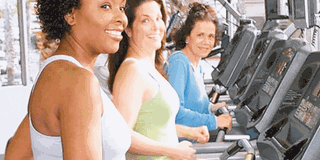Keeping safe while on the treadmill

Most people don’t expect to start a run at the gym and finish it in the hospital. But treadmill-related injuries sent 24,400 people to the emergency room in 2014, according to the Consumer Product Safety Commission (CPSC). Use the safety features. All treadmills come equipped with a safety key you can clip to your clothing. If you do slip, the key pulls out and immediately stops the belt. Use it rather than leaving it twisted around the handrail or hanging down the side. Make use of the “stop” or “pause” buttons to halt the machine if you need to hop off mid-workout. You’re much more likely to lose your footing when stepping back on a moving belt. And if you step away from the machine while it’s running, another runner may step on without realizing the belt is moving—a recipe for disaster.
Check your clearance. Fitness facilities must allow 48 inches. That’s a good guideline to follow with home treadmills, too. Hard concrete or cement flooring could increase your risk for a major injury if you do fall. Consider rubber matting or thin carpet that cushions the blow without interfering with the calibration or balance of the machine.
Stay controlled. You can run a solid speed workout on a treadmill. After all, that’s the whole premise of Henwood’s studio. But sprinting too hard can increase your risk of injury, he notes. Use the rate of perceived exertion scale, where zero is standing still and 10 is an all-out sprint, and try not to exceed nine out of 10.
Keep children away. Some of the most tragic treadmill injuries occur not among runners, but among kids who play on or near the equipment. If you have a home treadmill, keep in it a room where you can lock the door .




